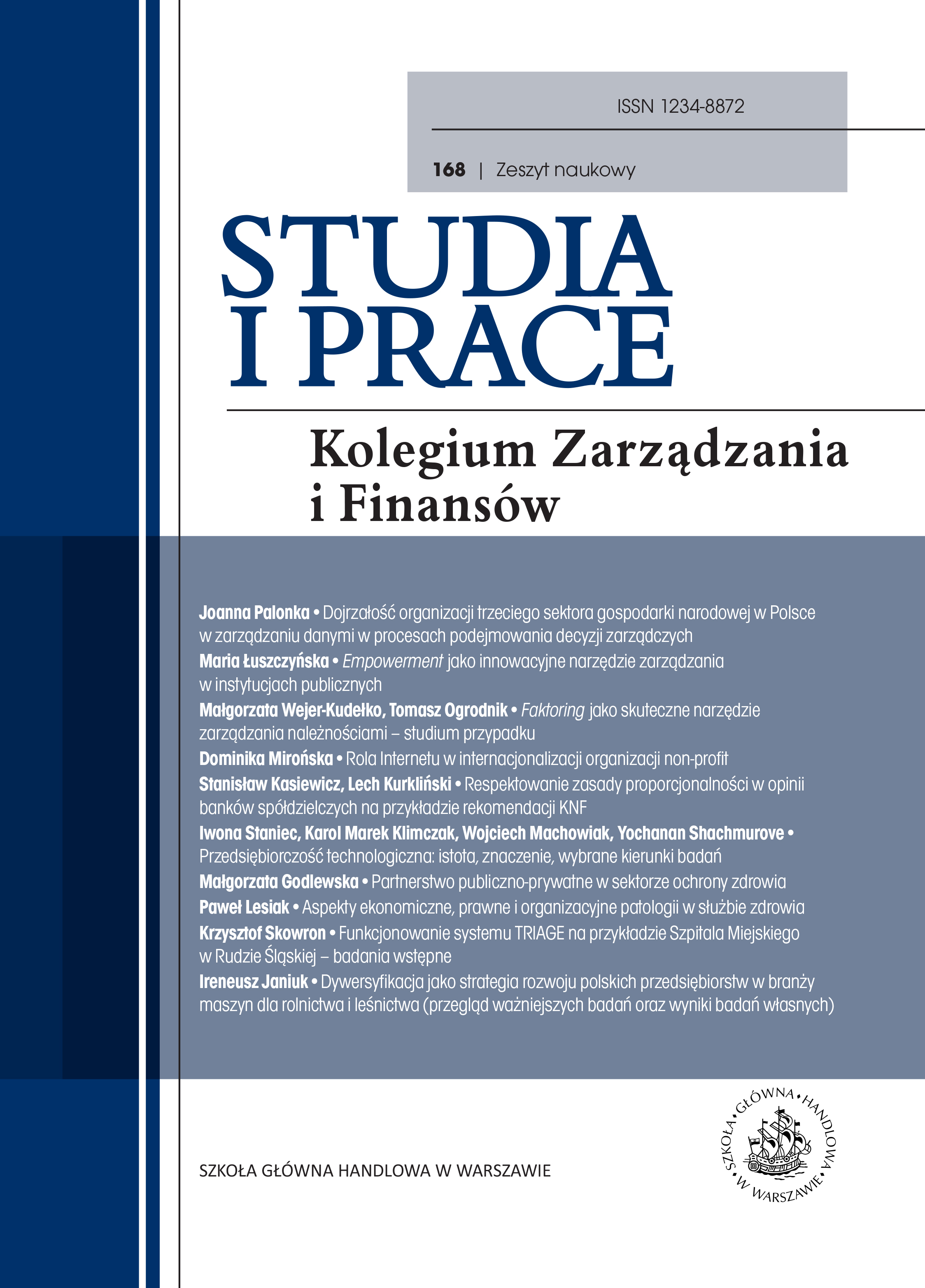Funkcjonowanie systemu TRIAGE na przykładzie Szpitala Miejskiego w Rudzie Śląskiej – badania wstępne
DOI:
https://doi.org/10.33119/SIP.2018.168.9Słowa kluczowe:
zarządzanie podmiotem leczniczym, TRIAGE, system segregacji pacjenta, jakość w ochronie zdrowia, zdrowie i bezpieczeństwo publiczneAbstrakt
W praktyce funkcjonowania podmiotów leczniczych szpitalne oddziały ratunkowe niemal na całym świecie stosują system TRIAGE, czyli system segregacji medycznej, wykorzystywany w zarządzaniu ryzykiem medycznym, stale obecnym w ratownictwie medycznym, pozwalający na przyporządkowanie pacjentów do grup pilności udzielenia pomocy medycznej, a także „zaadresowaniu” ich do stosownych dla nich oddziałów szpitalnych. Artykuł prezentuje wyniki wstępnych badań, dotyczących funkcjonowania systemu TRIAGE na Izbie Przyjęć wybranego zakładu leczniczego, w szczególności: prawidłowości zapoznania pacjentów z wprowadzonym systemem segregacji, szybkości i adekwatności udzielania pomocy, wpływu wprowadzenia systemu na usprawnienie funkcjonowania Izby Przyjęć oraz zadowolenia pacjentów z jakości obsługi na Izbie Przyjęć.
Downloads
Bibliografia
2. Conrad M., Stoppler M. D., Shiel W. C. Jr., Medical Triage: Code Tags and Triage Terminology, http://www.medicinenet.com/script/main/art.asp?articlekey=79529
3. Dąbkowska M., Rozpoznawanie zespołu stresu pourazowego, „Neuropsychiatria i Neuropsychologia” 2008, no. 2, vol. 3.
4. Dietrich A., Shaner S., Campbell J., Pediatric Basic Trauma Life Suport, Basic Trauma Life Support International, Oakbrook Terrace 2002.
5. Hładki W., Traczewska H., Lorkowski J., Trybus M., Segregacja medyczna w zdarzeniach masowych, „Ostry Dyżur” 2010, t. 3, no. 1.
6. https://serwiszoz.pl/pacjent/system-segregacji-medycznej-case-study-3318.html
7. Jakubaszko J., Struktura i funkcja Szpitalnego Oddziału Ratunkowego, „Medycyna Intensywna i Ratunkowa” 1999, wyd. II, 1.
8. Medycyna katastrof, red. A. Zawadzki, PZWL, Warszawa 2006.
9. Medycyna zagrożeń i urazów radiacyjnych, red. M. Janiak, A. Wójciak, PZWL, Warszawa 2005.
10. Raczyński A., System TRIAGE, http://www.centrumtriage.pl/system-triage.html
11. Ramenofsky M. L., Ramenofsky M. B., Jurkovich G. J., Threadgill D., Dierking B. H., Powell R. W., The Predictive Validity of the Pediatric Trauma Score, „The Journal of Trauma” 1988, no 7 (28).
12. Rasmus A., Gaszyński W., Jaka pomoc doraźna?, „Ratownictwo Polskie” 1996, wyd. 1.
13. Ratownictwo medyczne w wypadkach masowych. Medycyna katastrof w zarysie, red. J. Ciećkiewicz, Górnicki Wydawnictwo Medyczne, Wrocław 2005.
14. Rutheford W., Definition and Classification of Disasters, „The Journal of Emergency Medicine” 1990, vol. 8, iss. 5, s. 591–595, www.jem-journal.com/article/0736–4679 (90) 90456–6/pdf
15. Sowa M., Winnicki A., Tarkowski M., Saletnik Ł., Segregacja medyczna poszkodowanych w obliczu zdarzeń masowych i katastrof, „Journal of Education, Health and Sport” 2015, nr 5 (10).
16. Tepas J. J., Mollitt D. L., Talbert J. L., Bryant M., The Pediatric Trauma Score as a Predictor of Injury Severity in the Injured Child, „Journal of Pediatric Surgery” 1987, no. 1 (22).
17. Ustawa z 8 września 2006 r. o Państwowym Ratownictwie Medycznym, tekst jedn. Dz.U. z 2013 r., poz. 757.
18. Wczesne postępowanie medyczne w katastrofach. Podręcznik dla ratowników medycznych, red. M. S. Briggs, K. H. Brinsfield, PZWL, Warszawa 2007.
19. Youngson R., Słownik encyklopedyczny. Medycyna, „Collins”, RTW, Warszawa 1997.









